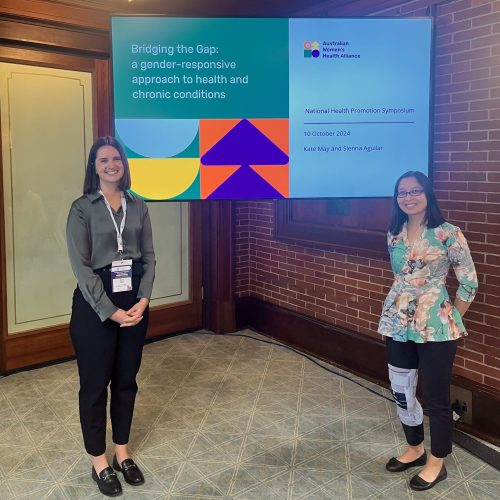Health promoters, including practitioners, educators, and sector leaders, gathered at the National Health Promotion Symposium in Ngunnawal Country, Canberra, to reflect, learn, and celebrate health promotion and the collective work being done to advance health and equity across the country.
As part of the symposium, which is organised by the Australian Health Promotion Association, Australian Women’s Health Alliance hosted an interactive workshop at Old Parliament House on 10 October, responding to the theme ‘Shaping the Future of Health Promotion.’
Led by Senior Project Officer Sienna Aguilar and Policy Advisor Kate May, the workshop, ‘Bridging the Gap: A Gender-Responsive Approach to Health and Chronic Conditions,’ covered the foundations of gender-responsive health before examining chronic conditions and women’s health policy as a case study.
Some takeaway messages included:
- Women live with more chronic conditions and pain than men across the lifespan.
- Women continue to report gendered bias, discrimination, and dismissal when seeking support for chronic conditions and pain.
- By acknowledging and addressing gendered inequities in research, policy, and practice, we can make positive change.
Participants were then encouraged to discuss how they could apply gender-responsive health to their work—whether in community health, academia, policy and beyond. Some of the responses included:
- consider gendered differences in policies and procedures in acute and community health care
- advocate that women’s symptoms might differ from men’s and can be easily misdiagnosed
- speak up and advocate for gender-responsive care.
The importance of lived experience
With more than half of women in Australia living with one or more chronic conditions, lived experience was central to the workshop presentation and the discussions in the room.
Kate shared her challenges in managing complex neurological and musculoskeletal conditions, while many participants reflected on how they had also observed or experienced gender inequities in their professional and personal lives.
The warm discussions with participants highlighted the importance of creating space for the voices of lived experience and the people on the ground working to support better health.
Statistics and policy are not enough on their own to identify and respond to inequities. The collective stories of people and communities who truly see or experience these issues offer essential insights on how to make meaningful change.
Why gender equity is important for shaping health promotion
Gender is a critical determinant of health, influencing differences in access to care, disease prevalence, health outcomes, and experiences within health care systems. By identifying and critically addressing gendered inequities, we can close gaps and prevent ill health and other harms.
Embedding a gender-responsive approach has the potential to create healthier and more equitable outcomes for everyone across the full spectrum of health care—from health promotion and prevention to primary and acute care.
One workshop participant captured the significance of this well:
‘Such an important topic, strongly linked to creating a more equitable approach to health!’
Workshop participant Tweet
The symposium provided a valuable opportunity to explore gender-responsive health and how it can be used in health promotion.
By continuing these discussions and increasing our knowledge and skills, we ensure that health promotion efforts are not only comprehensive but also equitable.
Our e-learning course Introduction to Gender-Responsive Health aims to ensure workplaces and individuals have the resources necessary to understand and apply a gender-responsive approach to health and prevention.
